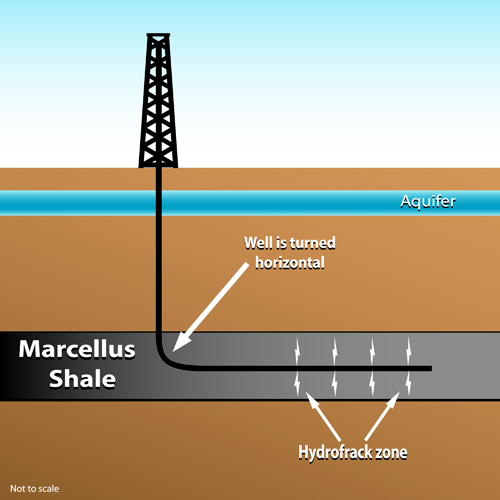NPDES FAQs for Fracking Operations in the Marcellus Shale—Part 2
 |
Q: If a publicly owned treatment works (POTW) were to consider accepting shale gas extraction (SGE) wastewater from a fracking operation, what wastewater information would the POTW need to collect?
A: To meet the requirements of its own NPDES permit, a POTW operator would need to assess the quality and quantity of the wastewater and subsequently determine the potential impacts to the POTW should the wastewater be accepted. To characterize SGE wastewater discharges, there are a number of things that would be examined, including concentrations of:
- Total dissolved solids,
- Specific ions, such as chlorides and sulfate,
- Specific radionuclides,
- Metals, and
- Other pollutants that could reasonably be expected to be present in wastewater from a well.
The EPA also notes that it is necessary to assess “all chemicals used in well drilling, completions, treatment, workover, or production that could reasonably be expected to be present in wastewater. Pursuant to the permit, this information must generally be reported to EPA and/or the State program before the POTW may accept the [hydraulic fracturing flowback water] HFFW.”
Forget expensive calls to lawyers and consultants. With Enviro.BLR.com, you get instant access, 24/7. Try it out today and get the 2015 EHS Salary Guide, absolutely free. Download Now.
Q: What does “adequate notice” mean with regard to a POTW accepting SGE wastewater?
A: According to the EPA, adequate notice “is meant to provide the EPA (or the state NPDES permitting authority) with enough time to determine if the POTW NPDES permit needs to be modified in order to address potential effects due to the potential new indirect discharger.” For example, the EPA notes that in Pennsylvania, where the state is the permitting authority and the EPA has authority for approving pretreatment, “the POTW must submit the required information to both agencies. In addition to this notification, all industrial user discharges to a POTW must comply with the specific prohibitions of 40 CFR 403.5(b), any applicable categorical standards, and any state and local limits.” To prevent notification requirements from being overlooked by POTW operators, the EPA Regions work with authorized states “to ensure that NPDES permits for POTWs include the pretreatment notification requirements and definitions of 40 CFR 122.2, 122.42(b), and 403.5(b).”
Everything You Need for Environmental Compliance
Enviro.BLR.com puts everything you need at your fingertips, including practical RCRA, CAA, CWA, hazardous waste regulatory analysis and activity, news, and compliance tools. Try it at no cost or risk and get a FREE report.
Q: Can SGE wastewater be discharged to a centralized waste treatment (CWT) facility?
A: Yes, CWTs may accept SGE wastewater transported from a fracking facility. Like POTWs, however, CWTs are also subject to regulations, specifically 40 CFR Part 437, which covers effluent limitation guidelines and standards. Again, the introduction of new pollutants that were not considered in developing the CWT effluent guideline may require additional limits, and the “NPDES regulations require that permit writers include technology-based limits developed on a case-by-case, ‘best professional judgment’ (BPJ) basis.”
For example, the EPA did not evaluate radionuclides in developing the CWT effluent guideline so permitting authorities will need to develop BPJ technology-based effluent limits to address radionuclides and incorporate those limits in the CWT facility’s NPDES permit. Permit writers developing these BPJ limits must consider the same factors the EPA uses in establishing categorical effluent guidelines, as defined in 40 CFR 125.3(d).
In addition, like POTWs, NPDES permits for discharges from CWTs to waters of the United States must also meet applicable water quality-based permitting requirements. This means that after a CWT applies technology-based effluent limits, if the discharge of wastewater “has a reasonable potential to cause or contribute to exceedances of water quality standards, the permit writer will need to develop water quality-based effluent limits (WQBELs) for the POTW’s or CWT’s NPDES permit to protect water quality.” In some states, additional requirements may also apply, and facility operators should consult the agency with authority to assess compliance with all regulations.
